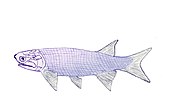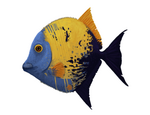Hulettia: Difference between revisions
rms syn (type species syn, not genus syn) |
Open access status updates in citations with OAbot #oabot |
||
| (2 intermediate revisions by 2 users not shown) | |||
| Line 15: | Line 15: | ||
== Species == |
== Species == |
||
The type species, ''H. americana'' is originally described as a species of ''[[Pholidophorus]]'' in 1899.<ref>[ |
The type species, ''H. americana'' is originally described as a species of ''[[Pholidophorus]]'' in 1899.<ref>[https://paleobiodb.org/classic/checkTaxonInfo?taxon_no=212144] C. R. Eastman. 1899. Jurassic fishes from Black Hills of South Dakota. Geological Society America Bulletin 10:397-408 9/22/14</ref> In 1984, its own genus name ''Hulettia'' is given, after [[Hulett, Wyoming]]. Holotype is known from [[Sundance Formation]] of [[South Dakota]], while other specimens are also known from [[Wanakah Formation|Wanakah (Summerville) Formation]], [[Todilto Formation]] and [[Ralston Creek Formation]].<ref name=":0">{{Cite book |last1=Schaeffer |first1=Bobb |url=https://www.biodiversitylibrary.org/bibliography/197680 |title=Jurassic fishes from the western United States, with comments on Jurassic fish distribution |last2=Schaeffer |first2=Bobb |last3=Patterson |first3=Colin |date=1984 |publisher=American Museum of Natural History |location=New York, N.Y}}</ref><ref name=":1">{{Cite book |last1=Kirkland |first1=D. W. |url=http://dx.doi.org/10.58799/b-147 |title=Middle Jurassic Todilto Formation of northern New Mexico and southwestern Colorado: Marine or nonmarine? |last2=Denison |first2=R. E. |last3=Evans |first3=R. |date=1995 |publisher=New Mexico Bureau of Geology and Mineral Resources|doi=10.58799/b-147 }}</ref> |
||
Second species, ''H. hawesi'' is described from [[Morrison Formation]] of Colorado. This species is named after William Hawes who found the holotype.<ref name=":2">{{Cite journal |last=Kirkland |first=James I. |date=1998 |title=Morrison fishes |url=https://www.researchgate.net/publication/ |
Second species, ''H. hawesi'' is described from [[Morrison Formation]] of Colorado. This species is named after William Hawes who found the holotype.<ref name=":2">{{Cite journal |last=Kirkland |first=James I. |date=1998 |title=Morrison fishes |url=https://www.researchgate.net/publication/292223569 |journal=Modern Geology |volume=22 |pages=503–533}}</ref> |
||
''H. americana'' reached their maximum standard length (excluding fins) of {{convert|15.5|cm|in}}, while ''H. hawesi'' is much smaller, with standard length of {{convert|5.85|cm|in}} (about {{convert|7.2|cm|in}} total length).<ref name=":0" /><ref name=":2" /> |
''H. americana'' reached their maximum standard length (excluding fins) of {{convert|15.5|cm|in}}, while ''H. hawesi'' is much smaller, with standard length of {{convert|5.85|cm|in}} (about {{convert|7.2|cm|in}} total length).<ref name=":0" /><ref name=":2" /> |
||
== Classification == |
== Classification == |
||
At 1984, it was classified as [[Halecostomi]] ''[[incertae sedis]]''.<ref name=":0" /> Later study shows that is likely a member of [[Neopterygii]], pan-[[holostean]].<ref>{{Cite journal | |
At 1984, it was classified as [[Halecostomi]] ''[[incertae sedis]]''.<ref name=":0" /> Later study shows that is likely a member of [[Neopterygii]], pan-[[holostean]].<ref>{{Cite journal |last1=Near |first1=Thomas J. |last2=Thacker |first2=Christine E. |date=2024-04-18 |title=Phylogenetic Classification of Living and Fossil Ray-Finned Fishes (Actinopterygii) |journal=Bulletin of the Peabody Museum of Natural History |volume=65 |issue=1 |doi=10.3374/014.065.0101 |issn=0079-032X|doi-access=free |url=https://zenodo.org/records/8352027/files/Near%26Thacker_preprint.pdf }}</ref> |
||
== Paleoecology == |
== Paleoecology == |
||
Latest revision as of 02:49, 11 December 2024
| Hulettia Temporal range:
| |
|---|---|

| |
| Type specimen | |
| Scientific classification | |
| Domain: | Eukaryota |
| Kingdom: | Animalia |
| Phylum: | Chordata |
| Class: | Actinopterygii |
| Subclass: | Neopterygii |
| Genus: | †Hulettia Patterson, 1984 |
| Type species | |
| Hulettia americana Eastman, 1899
| |
| Other species | |
| |
Hulettia is an extinct genus of ray-finned fish known from United States. This fish genus contains two species, H. americana and H. hawesi.
Species
[edit]The type species, H. americana is originally described as a species of Pholidophorus in 1899.[1] In 1984, its own genus name Hulettia is given, after Hulett, Wyoming. Holotype is known from Sundance Formation of South Dakota, while other specimens are also known from Wanakah (Summerville) Formation, Todilto Formation and Ralston Creek Formation.[2][3]
Second species, H. hawesi is described from Morrison Formation of Colorado. This species is named after William Hawes who found the holotype.[4]
H. americana reached their maximum standard length (excluding fins) of 15.5 centimetres (6.1 in), while H. hawesi is much smaller, with standard length of 5.85 centimetres (2.30 in) (about 7.2 centimetres (2.8 in) total length).[2][4]
Classification
[edit]At 1984, it was classified as Halecostomi incertae sedis.[2] Later study shows that is likely a member of Neopterygii, pan-holostean.[5]
Paleoecology
[edit]Formations that H. americana known are considered as marine environment,[3] while Morrison Formation where H. hawesi described shows freshwater environment.[4] Discovered specimens show evidence of predation upon the smaller species of fish Todiltia.[6]
See also
[edit]References
[edit]- ^ [1] C. R. Eastman. 1899. Jurassic fishes from Black Hills of South Dakota. Geological Society America Bulletin 10:397-408 9/22/14
- ^ a b c Schaeffer, Bobb; Schaeffer, Bobb; Patterson, Colin (1984). Jurassic fishes from the western United States, with comments on Jurassic fish distribution. New York, N.Y: American Museum of Natural History.
- ^ a b Kirkland, D. W.; Denison, R. E.; Evans, R. (1995). Middle Jurassic Todilto Formation of northern New Mexico and southwestern Colorado: Marine or nonmarine?. New Mexico Bureau of Geology and Mineral Resources. doi:10.58799/b-147.
- ^ a b c Kirkland, James I. (1998). "Morrison fishes". Modern Geology. 22: 503–533.
- ^ Near, Thomas J.; Thacker, Christine E. (2024-04-18). "Phylogenetic Classification of Living and Fossil Ray-Finned Fishes (Actinopterygii)" (PDF). Bulletin of the Peabody Museum of Natural History. 65 (1). doi:10.3374/014.065.0101. ISSN 0079-032X.
- ^ http://nmnaturalhistory.org/hulettia.html Archived 2014-09-08 at the Wayback Machine New Mexico Museum of Natural History, 1999





